Princess of Wales, Prisoner of War
The tabloids portrayed her as a style icon, royal watchers dismissed her as an attention whore and, recently, the Netflix series The Crown honoured her as an unhappy yet unforgettable member of the royal history. To Pablo Larraín, however, princess Diana Spencer was a P.O.W. The elegantly written labels attached to the different dresses she needed to wear all carry these same initials. Being the Princess of Wales means no more, no less than being a Prisoner of War. Stripping the mythologized story of its tiaras and ballrooms, Larraín recounts one of the court’s yearly Christmas weekends in the countryside: a three-day trip replete with hollow formalities and continuous make-belief, that dismantles Diana’s mental resilience. She suffers from the constant pressure to erase her own personality in favour of the royal role she has to perform.
Actively taking part in this complex role play, Kristen Stewart performs the part of Diana Spencer who, in turn, performs the part of the Princess of Wales. The actress is playing an actress. With small but decisive movements—a blink of the eye or a bow of the head—Stewart intentionally creates a facial vacuum in which the layered, emotional richness of the character is given the space and time to unfold. The visual style Larraín developed throughout his previous films suits Stewart’s performance perfectly: centred in the middle of the frame, she often faces the camera or even stares right through it. Whereas this particular portrait style seemed merely a form of arbitrary aestheticism for the sake of aesthetics when used in, for example, Ema (2019), his last Chilean film, they now enhance Stewart’s suggestive acting style as well as Diana’s profound loneliness.
The strength of the film depends heavily on the efforts of yet another talented woman. Cinematographer Claire Mathon, who often works with Céline Sciamma, refrains from portraying the three depicted winter days as a dark and gloomy source of seasonal depressions. Filming with a 16 and a 35mm camera, she makes the cold visible, the air tangible and the diffuse sunlight palpable. Brightly illuminated and highly textured, Mathon’s photography contrasts with Diana’s feelings of imprisonment and alienation, and, hence, differs strongly from the steering soundtrack composed by Jonny Greenwood. Orchestral baroque scores accompany the royal formalities, while jazz music emphasizes Diana’s longing for freedom. During the several mental breakdowns and delusions she experiences, the music increases in intensity and idiosyncrasy. It aims to enhance her inner suffering, but, in doing so, becomes too expressive or even expressionist, leaving almost nothing to the imagination.
Exploring too many narrative pathways, Larraín unfortunately overrules the simplicity and implicity created by Stewart and Mathon. On top of the basic story elements which reveal Diana’s struggle, he adds a series of flashbacks to her childhood; the recurrent appearance of the ghost of Anna Boleyn, with whom Diana is obsessed; a car pool karaoke-styled road trip; and an unnecessary lesbian subplot. The sudden exposure of love, at the end of the film, that is preceded by a subtle build-up of romantic energy between the princess and her maid, is merely a cheap act of tokening devoid of any importance to the story itself. Trying to free her from prejudices and rumours, Larraín tends to capture her once again within a closed frame. Lady Di remains a POW.
